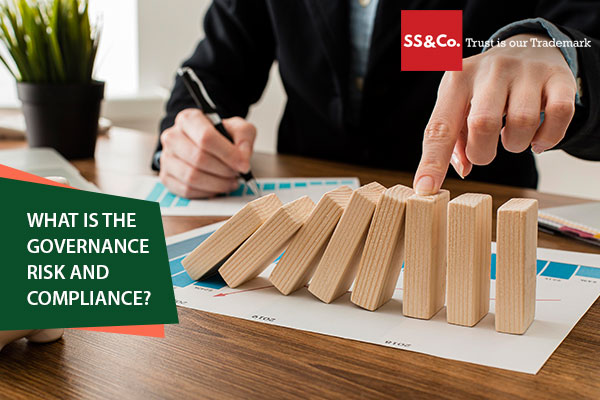What is Governance, Risk, and Compliance?

In a rapidly revolutionizing business world where everything is impacted by technological change, globalization, and regulatory evolution, businesses face multiple challenges on a day-to-day basis. Governance, Compliance, and Risk are the three core parts of any business to integrate discipline and necessitate a balance between profit-driven, risk-taking, and prudent business control. Businesses that fail to do so result in unregulated strategies, which expose them to legal and operational risks. Consequently, GRC has gained prominence in the last couple of years as it facilitates organizations in building a cohesive model guiding organizations to perform effectively, manage unpredictability, and maintain trust. This blog will further explore why GRC matters, its benefits, challenges, and importance in the Saudi Market.
Getting to Know GRC
The GRC is the process that helps an organization to detect risks, audit the internal systems, assess the effectiveness of governance before making any decision, and recommend the best practices that can be used to enhance business performance. The integrated approach of Governance, risk, and compliance is to treat them all in an interrelated manner that aids in achieving objectives, underlining uncertainties, and taking prompt action. This concept emerged in the 2000s. Before that, businesses used to handle governance, risk, and compliance activities separately. However, this approach needed separate teams with duplicate efforts, poor results, and inconsistent reporting. With a unified GRC framework, organizations gained better transparency, proficiency, and effective risk management.
The Three Elements of GRC
To thoroughly understand the GRC framework, it is important to grasp the three pillars: Governance, Risk, and Compliance. Which we will deeply understand here.
1. Governance
Governance is defined as the processes, rules, and culture by which an organization is controlled, organized, and directed towards a path. Considering governance in GRC, it’s about making sure that your organization’s strategy, policies, and controls are all in line to make intelligent decisions that are effective and accountable. The core elements of governance include,
- Creating transparent direction and objectives
- Designating responsibilities to the board, management, and other team members
- Guiding the behaviors and operations through smart policies and processes
- Keeping track of performance to make sure that it is fully aligned with regulatory needs
- Implementing control mechanisms to ensure oversight and responsibility
So, one can say that governance is not about reacting to the risks and compliance needs but proactively handling them in an ethical way.
2. Risk (Risk Management)
The Risk Management factor is to detect, analyze, respond, and monitor risks as a priority to guard a business from any hurdles in achieving its routine operations. In the GRC context, risk is not considered just a stumbling block but an opportunity.
The core risk management steps include,
- Identification of internal and external risks that might influence business operations.
- Assessing the probabilities and assessing an organization’s risk tolerance capability
- Considering the best possible tricks to respond by either accepting or transferring risks, or avoiding and minimizing them
- Keep a track and control of risks to keep the environment safe and monitored
- Making sure that the risk analysis leads to intelligent strategic and operational decisions.
With high-performing risk management, businesses can forecast and respond preventively to disruptions, adaptive culture and complexities, and even utilize it for finding better opportunities.
3. Compliance
Compliance is important to adhere to the laws, regulations, policies, and industrial standards that are set by any country. Compliance is the core pillar of any thriving business. Without it, businesses cannot stand strong for a long time. In GRC, Compliance is mandatory for any organization to operate within its legally permitted boundaries and to meet the needs of shareholders, and to stand out in the market.
Major Compliance components are,
- Getting awareness of regulatory needs as per the industry, like which standards apply, tax legislation, and environmental laws
- Creating policies to internally control and develop plans for complete compliance
- Monitoring, auditing, and documenting compliance status
- Immediately acting against any compliance failures through investigations, prompt actions, and disclosures
- Integrating a culture of compliance in a business environment and developing ethical behaviors.
The Integrated Approach
All three components of GRC have a distinct approach, but by merging Governance, Risk, and Compliance altogether, businesses can gain a market edge. The governance factor gives the right direction; risk management ensures that organizations stay updated with the current and forthcoming risks, while compliance is crucial to keep the business within its legal boundaries. They all work collectively under one team, which not only elevates proficiency but also minimizes the cost. The key benefits behind this merging include,
- Oftentimes, compliance complexities and risk tasks overlap, like internal control monitoring is used for both compliance and risk, and GRC helps to mitigate this duplication
- Clarity in decision-making is also achieved through GRC, which keeps everything under one unified dashboard.
- With a single GRC system, businesses can stay safe from disconnected systems, organizational silos, and misaligned performance measures. This helps in utilizing resources optimally
- The integrated GRC systems facilitate responding to any emerging risks, changes in regulations, and stakeholders’ demands ahead of time.

Why GRC Matters?
Many factors that make GRC a need of day of businesses are,
- Regulatory Needs: The international businesses are facing an increase in regulations and standards, which makes compliance risky and expensive. GRC together eases compliance and reduces the cost
- Technological Transformation: The advanced digital systems, cloud computing, big data, and AI expose businesses to cyberthreats, data gaps, and third-party risks, which GRC helps to address effectively
- Interconnected Risks: today, risks are interconnected, which gives rise to damage in finances, reputation, and compliance. With a single system handling all, these harms can be mitigated
- Cost Optimization: Businesses that operate under pressure produce more with less. With GRC, not just the duplication is reduced, but also the extra overhead needed is also lowered
- Smart Growth and Resilience: Companies that take care of their governance, risk, and compliance factors more competently are positioned well to gain better opportunities.
Challenges in GRC Implementation
Even though GRC has its own benefits, it also comes with some challenges, like:
- Many businesses still operate traditionally with governance, risk, and compliance separately, and the integration demands evolution in culture, systems, and teams, which they face challenges in implementing
- Without having a strong leader on board, the GRC is not implemented professionally, which makes GRC an optional choice rather than a mandatory requirement.
- Staying updated with the shifting laws, industrial standards, and global laws can be intricate for the teams, specifically for multinational businesses
- GRC needs a huge number of investments in technology, building skilled teams and operations, which many organizations lack, mainly SMES that have limited budgets
- The change management is complex for the companies running on legacy systems and non-skilled teams that are not very familiar with the latest technological needs, hence they face resistance from employees
- Oftentimes, businesses adopt too many tools, which elevates the burdens and complexities rather than reducing them
- New risks emerge with the new systems, like digital disruptions, cybersecurity concerns, and AI, which demand upgraded security protocols
Tailoring GRC to Strategic and Operational Contexts
GRC (Governance, Risk, and Compliance) must be utilized in both strategic management and operational execution. This ensures that business objectives are supported through GRC rather than acting as an added burden on teams.
1. Linking GRC to Strategy
GRC needs to align with business goals, which assist them in achieving success instead of just avoiding risks. This is done by detecting and managing risks that come with governance, local regulations, and legal compliance. Additionally, it is also important to evaluate cyber risks, data protection, and governance of technology initiatives. This strategic alignment is essential for thoughtful decisions and sustainable growth possibilities.
2. Operationalizing GRC
Incorporate risk assessment and controls in your routine business operations across different departments. Develop a compliance mapping process to ensure a regulatory environment. Furthermore, regularly report the status of risks and compliance and utilize technological tools for automation. This will lead to a robust, responsive, and goal-oriented enterprise.
3. Role of Leadership, Board, and Culture
Having committed leaders is one of the foundational steps of GRC effectiveness. They not only define risk tolerance but also ensure proper governance structures and allocate resources proficiently. GRC is not just bound to compliance teams, but it’s an enterprise-wide duty that asks for a culture of transparency, ethics, and commitment, which is simply out of question without strong leadership.
GRC Services Saudi Arabia
Governance, risk, and compliance (GRC) is one of the most crucial elements of the rapidly shaping Saudi business world. GRC not just focuses on bringing clarity and adaptability to businesses, but it also safeguards businesses from risks, boosting governance, and handling Saudi Regulatory needs preventively.
Accounting firms like SSCOKSA play a key role in implementing the best practices to comply with GRC services in Saudi Arabia. Instead of picking different vendors and teams for governance, risk, and compliance, we offer an all-in-one service to meet your every operational need, cultural demand, and technological advancement.

